Listen to the Podcast
16 Feb 2024 - Podcast #869 - (19:16)
It's Like NPR on the Web
If you find the information TechByter Worldwide provides useful or interesting, please consider a contribution.

If you find the information TechByter Worldwide provides useful or interesting, please consider a contribution.
Excire dropped the other shoe in January. I wrote about the the company’s standalone Excire Foto in December and hoped that some of the new features in that remarkable application would make their way to Excire Search, a plug-in for Adobe Lightroom Classic. My wish has been fulfilled and anyone who has been frustrated by trying to find a specific image should prepare to be delighted.
Excire Foto is intended for users of Lightroom and other applications such as Exposure X7, Affinity Photo, Luminar AI, On1 Photo Raw, or any other photo organizing and editing application that is not Adobe Lightroom Classic. Excire Search is the application that works with Lightroom Classic as a plug-in.
Lightroom and Lightroom Classic share many features, but Lightroom runs on desktop, mobile, and web devices, stores images to the cloud by default, and has a smaller feature set. Lightroom Classic stores images locally, runs only on MacOS and Windows computers, and includes capabilities still absent from Lightroom. Both are included in Adobe’s photo plan, along with Photoshop.
Click any small image for a full-size view. To dismiss the larger image, press ESC or tap outside the image.
Excire Foto added a Find by Text Prompt option that goes far beyond the earlier version’s functionality. Searching for “two people in front of a car” returns images that Excire Foto thinks are good matches. This feature wasn’t available in the original version of Excire Search or the plug-in for Lightroom Classic. Now it is!
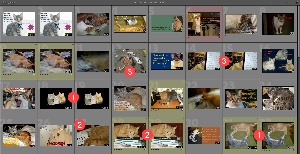 Knowing that some images in the photo files on my hard drive had both cats and text, I tried searching for “cats with text”. The results included a few errors (1) with cats but no text, but it caught some images with (2) obscure text (a cat leaning on a book, for example), and even more (3) obscure examples such as text included in a street mural of cats, and a cat in the background behind a tablet computer with text. That’s impressive.
Knowing that some images in the photo files on my hard drive had both cats and text, I tried searching for “cats with text”. The results included a few errors (1) with cats but no text, but it caught some images with (2) obscure text (a cat leaning on a book, for example), and even more (3) obscure examples such as text included in a street mural of cats, and a cat in the background behind a tablet computer with text. That’s impressive.
You’ll see that there are some duplicate images. That’s my fault, not a problem with Excire Search or Adobe Lightroom Classic. In the early days, before Lightroom existed, I sometimes saved multiple copies of images. Since then, I’ve deleted the unneeded extras whenever I’ve found them. Many remain, but Excire Search can help with that, too.
The most significant new feature is the ability to search based on a plain language description of what the user is looking for, but Excire Search offers several other powerful ways to find images:
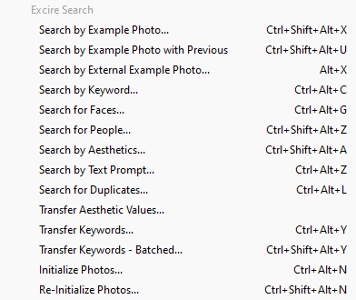
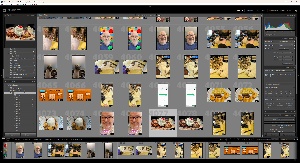 Excire creates a duplicates search result that’s separate from the standard search results. It won’t be overwritten by your next search and if there are more files than you can deal with in a single session, you can open the collection at a later time as you work through the process of eliminating unneeded duplicates. In more than 70,000 photos, I still had 1859 duplicates. Not all of those duplicates were unwanted, though. In cases where I had captured three or five images to create a high-dynamic range photograph or where I had used multiple focus points to create an image with extreme depth, the duplicates are needed.
Excire creates a duplicates search result that’s separate from the standard search results. It won’t be overwritten by your next search and if there are more files than you can deal with in a single session, you can open the collection at a later time as you work through the process of eliminating unneeded duplicates. In more than 70,000 photos, I still had 1859 duplicates. Not all of those duplicates were unwanted, though. In cases where I had captured three or five images to create a high-dynamic range photograph or where I had used multiple focus points to create an image with extreme depth, the duplicates are needed.
After installing Excire Search or updating a previous version, you’ll need to initialize the photos. This is required even for updates because the structure of the database has changed. This can be a time consuming process because the software makes a thumbnail image for each photo and then analyzes each image.
Professor Erhardt Barth, one of Excire’s founders and “basically the creator of Excire” according to managing director Mathias Martinetz, says processing will be slower if the images are on external drives. He notes that just creating previews in Lightroom can take longer with external drives. Initializing more than 40 thousand files stored on an internal drive took about an hour on Barth’s computer, compared to about 6 hours for 70 thousand files on my computer.
The applications have been developed by Pattern Recognition Company that was founded in 2005 as a spin-off of the University of Lübeck. Pattern Recognition Company’s expertise is in developing AI products and applications for automated image analysis is based on experience in machine learning, neural networks, and computer vision.
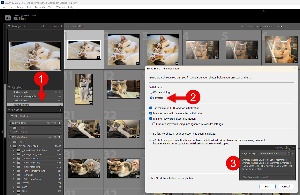 During initialization, either first time or when new photos are added to Lightroom Classic, the user will choose Initialize Photos from the Excire Search menu. The first time the process is run, you should initialize the whole catalog. After that, ensure that (1) Previous Import is selected under the Catalog tab and then choose (2) Filmstrip. Select Use maximum CPU load for initialization, Transfer aesthetic values after initialization, and Transfer keywords after initialization options. This way you can be sure that you will be able to see Excire’s applied keywords and aesthetic scores in the (3) Lightroom interface.
During initialization, either first time or when new photos are added to Lightroom Classic, the user will choose Initialize Photos from the Excire Search menu. The first time the process is run, you should initialize the whole catalog. After that, ensure that (1) Previous Import is selected under the Catalog tab and then choose (2) Filmstrip. Select Use maximum CPU load for initialization, Transfer aesthetic values after initialization, and Transfer keywords after initialization options. This way you can be sure that you will be able to see Excire’s applied keywords and aesthetic scores in the (3) Lightroom interface.
In normal use, the process adds very little time when adding new photos. To keep everything up to date, it’s important to initialize the new photos after using Lightroom Classic’s import function. Even with my photos being stored on an external drive, the initialization process takes only a minute or two for around 100 images.
Those who are new to Excire Search or new to the 2024 update should pay close attention to a series of helpful messages that Excire sends. Each explains plainly and concisely how to make the best use of the application. Some of the tips may seem obvious, but even those users who have experience with the previous version will almost certainly learn some new techniques or discover additional usages that make the process of finding just the right image easier.
Nearly any Lightroom Classic user will find Excire Search 2024 to be a useful addition, but acquiring Excire Foto might also be helpful because it can search for files based on GPS information. That’s not an option in Excire Search.
Excire offers a comfortably long 15-day trial period, so you can take a look and see if any of the application’s features appeal to you. For more information, visit the Excire website.
Manufacturers of hardware reviewed on TechByter Worldwide typically loan the hardware and it must be returned at the end of the review period. Developers of software reviewed on TechByter Worldwide generally provide a free not-for-resale (NFR) license so that all features of the application will be unlocked.
Although Microsoft 365 continues to improve, not everyone likes the idea of monthly or annual rental payments for software. Some resist the concept of paying for software at all. In either case, Libre Office is an excellent choice.
Thinking ahead, those who are opposed to software rental plans may have a decision to make in the next few years because there are persistent rumors that Microsoft will eliminate the current plan in which users pay for the operating system once when they buy the computer and updates are provided without cost for as long as the computer remains in service.
Several large software developers such as Adobe already charge a monthly fee that provides a reliable source of income so that the company can maintain a staff of planners, managers, and developers to work on new features and fix errors. If you decide a few years from now to opt out of all software for hire programs, a lot will change. Those who have already migrated to an open source office suite such as Libre Office will at least be able to continue using those applications without interruption because it works just fine under Linux.
Microsoft continues to create more helpful applications and intends to increase the utility of artificial intelligence. Relatively new applications such as Teams and Loop join office suite standards such as Word, Excel, PowerPoint, and Access. OneNote and other programs combine to create powerful enterprise systems.
Not every business has thousands of users who need to be able to share documents across the company’s LAN, though. And despite the modern look and functionality of programs such as Teams and Loop, home and small office users get along just fine with the basics. Libre Office version 24 certainly covers the basics and a lot more.
If you think Microsoft does weird numbering, consider Libre Office. Not long ago, the latest version was 7.6 and now it’s 24.2. There were no versions between 7 and 24. But if Microsoft can count 1, 2, 3, 95, 98, 2000, Me, XP, Vista, 7, 8, 10, and 11, then I suppose Libre Office can skip 17 version numbers.
OK, so seriously they didn’t really skip 17 versions. They’ve simply switched to a new numbering system. Because the latest version was released in February 2024, it’s 24.2. Enough of that, though. What we really want to know is what’s new!
Despite the dramatic numbering change, there are few big enhancements. There’s no equivalent to Microsoft’s One Note, Outlook, Loop, or Teams, but all the basics are present and well accounted for: Writer (Word), Calc (Excel), Impress (PowerPoint), and Base (Access). Libre Office also includes Draw, Chart, and Math.
Click any small image for a full-size view. To dismiss the larger image, press ESC or tap outside the image.
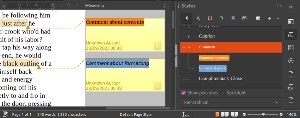 Writer: By default the Save AutoRecovery information function is active, print preview is better, and menu options are more in line with Microsoft 365’s UI. Support for ordered list numbering used in legal documents has been added and comment characteristics can now be changed globally because comment styles are associated with the comments.
Writer: By default the Save AutoRecovery information function is active, print preview is better, and menu options are more in line with Microsoft 365’s UI. Support for ordered list numbering used in legal documents has been added and comment characteristics can now be changed globally because comment styles are associated with the comments.To see the full list of changes, visit the release notes page.
Calling some of the keys on our keyboards “useless” may be overdoing it a bit, but Microsoft seems to be intent on adding lots of specialized keys even if they’re not particularly useful. The latest case in point is the Copilot key.
It’s clear that Microsoft CEO Satya Nadella intends for Microsoft to be the dominant player in artificial intelligence. It’s also clear that artificial intelligence can go well beyond plagiarism. AI may not (yet) be able to create anything truly new, but it can step up to perform mundane tasks.
The first inkling of this for me occurred shortly after 9/11. I was in Boston. The airport was closed indefinitely and I needed to arrange for a flight back to Columbus on Saturday. Automated attendant phone systems were far short of today’s artificial intelligence, but the American Airlines system let me reschedule to a flight that would depart from Manchester, New Hampshire. The problem was that the flight from Manchester had a stop at LaGuardia. It was unclear how that would work out, but I booked the flight.
The next day it was announced that Boston’s Logan airport would open on Saturday. Another call to the automated attended let me re-schedule through Logan. The flight was late departing but otherwise routine. What impressed me was the automated system’s ability to handle the changes without involving humans.
Click any small image for a full-size view. To dismiss the larger image, press ESC or tap outside the image.
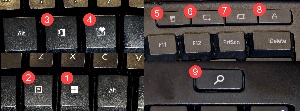 So here we are, 23 years later, with even better systems and soon a new key on our keyboard to connect us with Microsoft Copilot. But do we need the key? Already my Microsoft ergonomic keyboard has the standard (1) Windows key, a (2) Menu/Context key, a (3) Microsoft 365 key, an (4) Emojis key, a (5) Calculator key, a (6) Screen Shot key, a (7) Desktop key, a (8) Lock key, and a (9) Search key.
So here we are, 23 years later, with even better systems and soon a new key on our keyboard to connect us with Microsoft Copilot. But do we need the key? Already my Microsoft ergonomic keyboard has the standard (1) Windows key, a (2) Menu/Context key, a (3) Microsoft 365 key, an (4) Emojis key, a (5) Calculator key, a (6) Screen Shot key, a (7) Desktop key, a (8) Lock key, and a (9) Search key.
Virtually all of these keys duplicate shortcut keys that already exist. So why do we need yet another key, the Copilot key, that already has a keyboard shortcut (WinKey-C)?
I don’t doubt that Copilot will be helpful, but keyboard real estate is limited. Manufacturers are already using stupid design to include the existing keys. Several manufacturers (HP in particular) often places the Power button beside the Backspace key. How idiotic is that? The user presses what’s believed to be the Backspace key and the computer shuts down.
Enough, already. If there’s already an easily learned shortcut for something, we do not need yet another key on the keyboard.